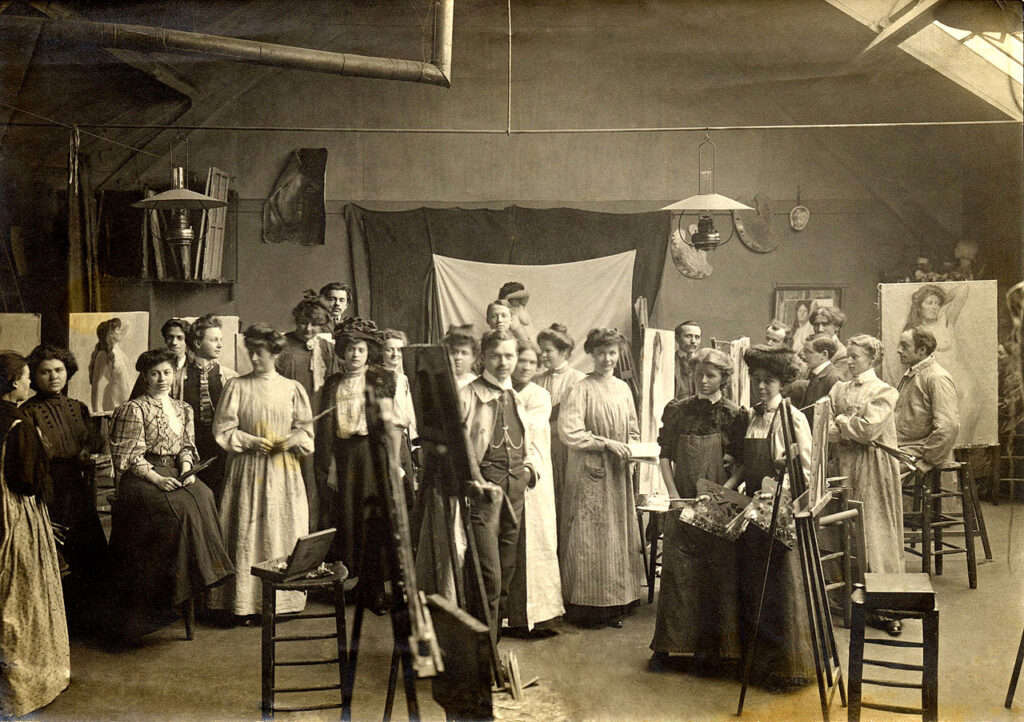From Countryside to Capital
Located at 49 Boulevard Montparnasse in Paris, the Académie Vitti was a private art school founded by a family of Italians from the Valle di Comino region, south of Rome. In 1889, Cesare Vitti, from Casalvieri, along with his wife, Maria Caira, and her sisters, Anna and Jacinta Caira, from nearby Gallinaro, set off for Paris to work as models for artists, a common practice at the time. With unfavorable economic and political conditions in Italy, as well as cholera and typhoid fever running rampant, thousands of people were left with no other option but to emigrate. And so, setting off on foot, the Vitti-Caira family left for France in hopes of finding new opportunities.
Montparnasse
The Montparnasse quarter of Paris was an intellectual hub of art and bohemian culture. By the 1880s, artists from all over the world were settling into studios and apartments in Paris.
Luckily for the Caira sisters, a favorite subject of many famous artists were Italian women. The Marché aux modèles (the “model market”) was one of the characteristic events held in the district each Monday, where scores of Italian men, women, and children showcased themselves in hopes of being selected by an artist.
But Cesare, Maria, and her sisters didn’t stop at modelling—they would go on to open their own private school.
An Art Academy for Women
At the time, women were excluded from attending official art courses, leaving them few options beyond a private tutor or atelier. In fact, women were not able to enroll in courses at the Académie des Beaux Arts until 1896. Finding this unjust, Maria Caira– also known as Mme Vitti– decided to take matters into her own hands. She scraped together enough money to rent an empty carriage house and turned it into a school for women. The Académie Vitti was one of the few institutions not only to accept female students, but to allow women the chance to sketch nude male models from life. Art students began arriving from all over the world in no time.
The Académie Vitti would soon become one of the most respected art schools in Paris, attracting giants like Paul Gaugin and Frederick William MacMonnies. Other teachers included Luc Olivier Merson (1846-1920), Jacques-Émile Blanche (1861-1942), Hermenegildo Anglada Camarasa (1871-1959), and Kees van Dongen (1877-1968).
A true international institution, the Académie Vitti welcomed female students from Europe, Latin America, and North America. Among them were Louise Eleanor Zaring (1872-1970) María Blanchard (1881-1932), and Janet Scudder (1973-1940). In 1912, Picasso sent several of his own pupils to study at the academy. The Académie Vitti operated for nearly 25 years, until the beginning of the First World War in 1914, when the Vittis decided to return to Italy, settling in the small town of Atina.
Académie Vitti Museum
In 2013, Cesare Erario, a descendent of the family, found a collection of objects in the attic of a house he had inherited—the very house the Vittis lived in upon their return from France. Today, the home in Atina is a museum showcasing a multitude of tokens and memorabilia, in addition to marvelous artworks. On display are over 90 nude sketches in pencil, charcoal, and chalk, as well as numerous paintings and drawings by Jacinta Caira. Equally interesting are the postcards and photographs of models taken by some of the greatest photographers of the time, among them Nadar and Naudet.
A Dream Fulfilled
Cesare Vitti, Maria Caira, and her sisters had accomplished what they had set out to do—and much more. They returned to Italy with pockets overflowing and a renowned school which, despite its closure, they could claim as their own. Theirs is a story of grit and determination in times of hardship. A beautiful interlacing of emigration and art, the Académie Vitti is a little-known sliver of history that continues to surprise and delight to this day.

